Physical Address
304 North Cardinal St.
Dorchester Center, MA 02124
High-energy midfacial trauma commonly results in naso-orbito-ethmoid (NOE) fractures, which present some of the greatest diagnostic and therapeutic challenges in facial trauma reconstruction. Fractures of the nasoethmoid region are defined as a midface fracture resulting in lateral displacement of the medial canthal-bearing segment of the medial orbital wall. These fractures may be isolated but frequently occur as part of more extensive “panfacial” fractures. The degree of comminution is proportional to the amount of trauma to the nasoethmoid skeleton, which also determines the degree of difficulty for reduction and primary repair. Nasoethmoid injuries are often misdiagnosed and inadequately treated because of the complex anatomy and technical challenges associated with this region. Failed management of nasoethmoid fractures in the primary setting can result in functional and cosmetic deformities that are difficult to correct secondarily. The pitfalls leading to secondary deformities are summarized in Box 3.5.1 .
Missed diagnosis
Inadequate operative exposure
Poor reduction and stabilization of bone fragments
Reduction plating placement in the medical canthal region
Undetected loss of normal nasal contours
Missed orbital defects
Failure to adequately reduce soft tissues in the naso-orbital valley
While nasoethmoid fracture management presents a challenge to even experienced surgeons, the best treatment of secondary nasoethmoid deformity remains its avoidance by the early diagnosis and appropriate treatment of the primary injury. Soft tissue swelling may obscure the severity of nasoethmoid fractures, so a high degree of suspicion is required to diagnose their initial presentation. The missed diagnosis and failed surgical treatment of nasoethmoid fractures can be best avoided with detailed knowledge of the surgical anatomy of this region, a thorough understand of the clinical presentation and management of such fractures, and a high degree of clinical suspicion. Once diagnosed, the treatment of nasoethmoid fractures remains one of the most difficult surgical repairs in facial trauma. It therefore remains somewhat common that patients present in a delayed fashion for both primary repair and secondary surgical revision ( Fig. 3.5.1 ).
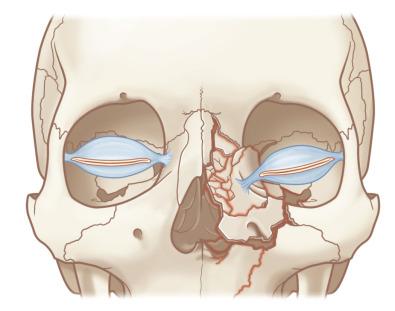
The treatment of secondary nasoethmoid fractures is more complicated and often results in inferior outcomes compared to optimal primary management. Posttraumatic tissue scarring and contour irregularities add complexity to delayed repair. The surgeon must widely expose the deformity, recreate the injury with selective osteotomies, and then reduce the tissue to its premorbid state with rigid bony fixation and soft tissue stabilization. The possibility of lost bone stock due to resorption of comminuted fragments increases the need for autogenous bone grafts, but this is rarely needed in the medial orbital wall. Soft tissue scarring and contracture result in the loss of elasticity and limit redraping the soft tissues with an optimal recreation of the subtle soft tissue contours that distinguish the nasoethmoid region. This chapter presents the senior author's approach to secondary nasoethmoid fracture repair, including case examples that illustrate the surgical management of these complex deformities ( Fig. 3.5.2 ).

The nasoethmoid skeleton consists of the confluence of orbital, nasal, maxillary, and cranial bones. Multiple facial buttresses support the nasoethmoid region, including the frontal process of the maxilla vertically and the supraorbital and infraorbital rims horizontally. Together these buttresses create a relatively stable anterior framework. Weakness exists posteriorly in the form of the thinner lacrimal and ethmoid bones of the internal medial orbital walls, which are prone to blow-out fracture and comminution. The inadequate reduction of displaced medial orbital rim and wall fragments results in a loss of definition of the naso-orbital valley. This may require wide scar release during delayed or revision surgery while taking care to avoid iatrogenic injury to the medial canthal tendon. Soft tissue buttressing may then be required for recontouring in secondary nasoethmoid fracture repair ( Fig. 3.5.4 ).
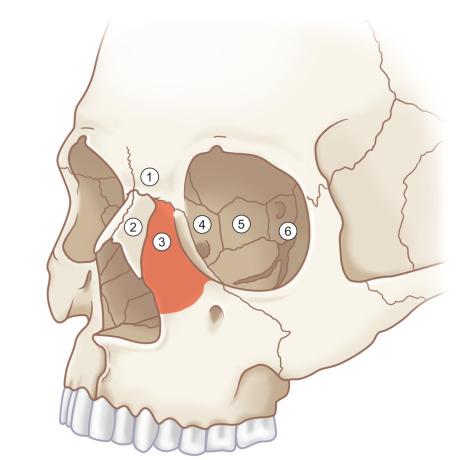
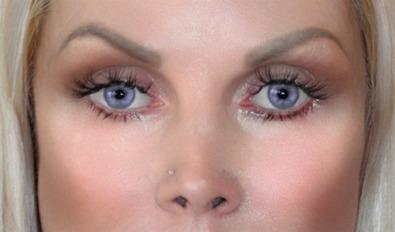
Between the two medial orbital walls and below the floor of the anterior cranial fossa lies the interorbital space, which consists of two ethmoidal labyrinths divided by the perpendicular plate of the ethmoid and nasal septum. Anterior to this region are the nasal bones, and care must be taken to avoid confusing fractures of these bones with those of the nasoethmoid region. The cribriform plate is found in the posterior roof of the interorbital space, which explains the occasional occurrence of persistent cerebrospinal fluid rhinorrhea or dysosmia with delayed nasoethmoid fractures. The interorbital space is both vulnerable to fracture from central midface trauma and adds complexity to the accurate diagnosis of nasoethmoid fractures, which may contribute to delays in presentation.
The single most important region of the medial orbital rim to optimal surgical repair of complex nasoethmoid fractures in both the acute and delayed setting is the “central bone fragment,” into which the medial canthal tendon inserts. There are three limbs of the medial canthal tendon. The anterior limb is distributed over the frontal process of the maxilla onto the posterolateral nasal bones. The superior limb inserts at the junction of the frontal process of the maxilla and the internal angular process of the frontal bone. The thin posterior portion inserts behind the lacrimal sac into the posterior portion of the lacrimal fossa. Nasoethmoid orbital fracture lines may extend through the frontal process of the maxilla, the medial orbital wall, inferior orbital rim, and lateral nasal bones, resulting in a mobile central medial orbital rim fragment. This can result in a mobile canthal-bearing segment, which can compromise the integrity of eyelid support ligaments and the contour of the palpebral fissure. The degree of displacement is often proportional to the extent of comminution, which varies greatly between injuries. An intimate knowledge of these anatomical relationships is essential to appropriately manage secondary nasoethmoid fractures, whose premorbid anatomy must be reapproximated despite being altered at the time of presentation ( Fig. 3.5.6 ).
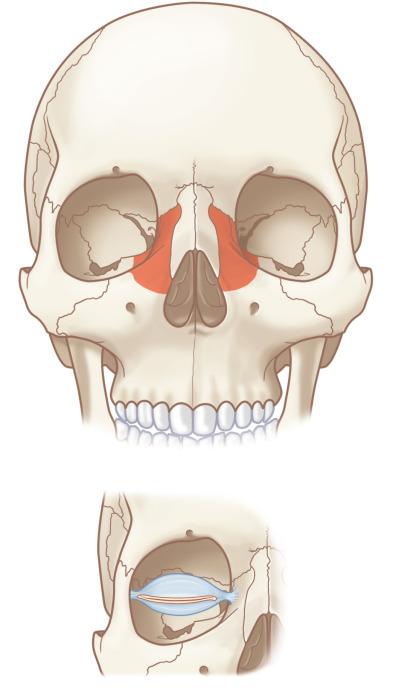
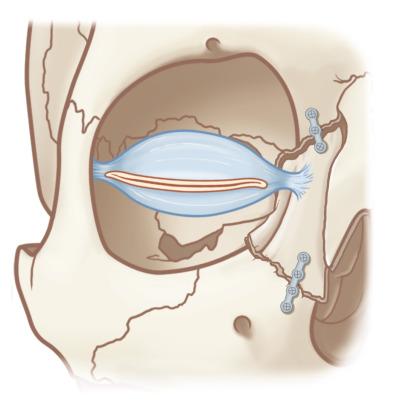
The delayed presentation of nasoethmoid fractures may occur after missed diagnosis or inadequate treatment of an acute injury, so the presentation may share certain elements of the original trauma setting with some important distinctions. The astute clinician should be mindful of the varied manner in which delayed nasoethmoid fractures may present in order to avoid repeating its misdiagnosis or inadequate treatment. A recent history of blunt trauma to the central midface is the typical presentation of the acute nasoethmoid fracture, but initial injury sequelae may not prompt presentation for weeks to months. Ideally, details of the original mechanism of injury and initial surgery would be obtained prior to any remote operative intervention. Without adequate primary nasoethmoid fracture repair, patients present with a variety of deformities, which are summarized in Box 3.5.2 .
Soft tissue scarring and contraction
Chronic central midface pain
Become a Clinical Tree membership for Full access and enjoy Unlimited articles
If you are a member. Log in here